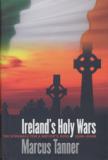Religious Apartheid
“Take religion away and the Irish are a pretty friendly people,” a Protestant woman from Derry remarked to Marcus Tanner, the author of this rather unfocussed history of religious conflict in Ireland. Tanner, the assistant foreign editor of the London Independent, came to the project as a reporter of the Drumcree situation of the late 1990’s, when Orange marches through a Catholic neighborhood were met by protests (some leading to violence) and prohibitions that threatened to derail the Northern Ireland peace process. The title, the dust jacket and the preface all lead the reader to anticipate a close examination of the origins and course of religious conflict in Northern Ireland. Tanner claims, with little foundation, that it is too common to see the Troubles as a contest between Nationalists and Unionists, ignoring its religious dimensions within the context of colonialism. I think most of the general public has long seen the conflict, in perhaps oversimplified terms, as Catholics versus Protestants, and certainly it is a maxim of Irish republicanism that the conflict is rooted above all in colonialism. Tanner doesn’t seem to know enough about Irish history to realize he is only reinventing the wheel.
But then he does not do even that. Mostly we see a history of Irish Catholicism since the Protestant Reformation, largely viewed through the bishops, a semi-institutional but erratic history, with occasional asides as to what is happening with the Protestant churches north and south, the colonial context forgotten after the first chapter or so. The story here is basically that of Catholic recovery, triumph and decay, and the setting is largely southern Ireland.
The Protestant Reformation actually began somewhat placidly in Ireland, but later the equation of religious conformity with loyalty led to a major transfer of land ownership from Catholic to Protestant hands, as new settlers were quite literally planted first in Ulster and by the mid-17th century in the provinces of Leinster and Munster. But even the Penal Laws of the early 18th century failed to dislodge the tenacious hold of the Catholic Church on the majority of the Irish people, although this code and the land confiscations it sought to preserve gave confessional differences in Ireland a decidedly class dimension.
Irish Protestantism’s last stand occurred in the 1820’s, the so-called Second Reformation, when attempts at mass conversions of papists failed dismally and instead provoked the march of Catholic recovery that began with Catholic Emancipation in 1829. From that point on, activists, priests and people banded together to pursue an increasingly nationalist agenda that triumphed in independence for southern, Catholic Ireland in 1921. Free to disregard the Protestant enemy now without (in the newly created Northern Ireland statelet), the Catholic Church focused on scapegoats within the new Free State’s boundaries, or so Tanner argues as he emphasizes repressive moral purity campaigns (suppression of dances and censorship), anti-Semitism and clerical flirtations with Fascism. Tanner sensationally documents an “atmosphere of religious apartheid” based on carefully selected stories of Protestant isolation and decline. That the Irish state is nearly theocratic is reflected in the oft-recorded efforts of Dr. Noel Browne to secularize the health care system in the 1940’s. The tyranny of religious near-homogeneity in the south is matched by the creation of a Protestant state for a Protestant people in the Orange State to the north, but Tanner persistently fails to differentiate northern Protestantism along confessional or class lines.
A hermetically sealed southern Catholicism, however, was pierced by censored novelists and especially radio and television, which brought the sinful, secular, modern Western world into Irish parlors. The ecumenism of the 1960’s seemed to mark the end of religious conflict in Ireland, but churches moved further apart as a result of the Troubles. Tanner’s assessment is that the churches helped to hold back their terrorist co-religionists, and by refusing to demonize the enemy kept Northern Ireland from being another Lebanon or Yugoslavia.
In a book filled with proclaimed turning points, Tanner marks the 1990 election of Mary Robinson as a “milestone in the history of the decay of Catholic Ireland.” What he means is that the secularization of southern Ireland, beginning with those first BBC broadcasts, led to efforts to soften Ireland’s rigid abortion and divorce policies. While the church prevailed in the 1980’s, it was at the cost of alienating substantial numbers of the flock. Alienation became a tidal wave in the 1990’s as one scandal after another rocked the church. There were bishops with illegitimate children and clerical pedophiles and the shocking systematic abuse of children at the hands of nuns and priests in church-run industrial schools tending to the orphaned. Mass attendance fell from 90 percent of the population in the Republic attending in the 1970’s to 50 percent today. Church scandals coincided with the extraordinary transformation of the Irish economy known as the Celtic tiger, reinforcing secularizing trends and, so, Tanner concludes, resolving Ireland’s religious wars.
This summary might make the book sound far more linear and focused than it is. But it is a rather irritating read to glean a rather well-known and accessible story. Tanner uses a kind of snapshot approach—ecclesiastical sites, persons and events open each chapter, though the connection to what follows is often tenuous. While big on verbal pictures, the book is very weak on analyzing them. It is like a family album, very familiar to insiders but bewildering if you don’t know the family. And the commentary provided is often wrong, grossly oversimplified or obvious. Ireland’s Holy Wars is neither a survey nor a considered analysis, and is likely to confuse the initiate and annoy the specialist.
This article also appeared in print, under the headline “Religious Apartheid,” in the July 29, 2002, issue.








